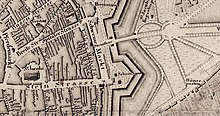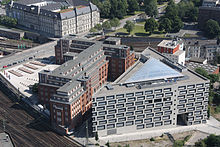Chicken post
Hühnerposten is a 150 meter long street in Hamburg-Hammerbrook on the northern edge of the Münzviertel . It is best known as the address of the striking building of the former railway post office , which has housed the central library of the Hamburg public library since 2004 . The street lies between two tracks of the nearby Hamburg main station and runs between Klostertor street in the west and Münzstraße in the east. The area south of the street has been redeveloped as the Neuer Hühnerposten district since around 2006 with office and hotel buildings, including the eight-story administration building of the Mobil Oil company health insurance fund, which was completed in 2007 .

The path was named as early as 1682, at that time it was outside the city directly in front of the ramparts . Different meanings have been handed down for the origin of the name: One says that there was an advanced guard at this place, which was unpopular with the guards because of its rural location and was accordingly reviled as a chicken post . According to another representation, there was a tavern here in the 17th century, in which "the residents from the dike area and from the Elbe islands let their colorful skirts fly while dancing", these "fluttering activities" then led to the corresponding name of the place.
In 1853 the cloister gate was built in front of the cloister wall, from which the street at the chicken post led into the Besenbinderhof . The gate lost its importance in 1861 when the gate was lifted , and at the same time the expansion of rail traffic made the place a traffic junction with the Hamburg Klosterthor train station , which existed on the southern part of the chicken post until 1903. With the completion of the main train station, traffic at Klostertor train station ceased and the central railway post office was built between 1902 and 1906 at Hühnerposten.
When creating the connecting curve from the former Lübeck train station to the new main train station in connection with the railway line coming from Berlin , the course of the street near the chicken post was probably cut through before 1912 and shortened by about 130 meters; the piece running east of the tracks has been part of the Besenbinderhof ever since .
Individual evidence
- ↑ a b Münzviertel report from January 30, 2006 (pdf; 1.14 MB) ( Memento from May 28, 2015 in the Internet Archive ), accessed on July 10, 2014
- ↑ Hamburger Abendblatt, August 20, 1982.
- ^ Christian Hanke: Hamburgs street names tell history , Hamburg 2006, ISBN 3-929229-41-2 , p. 189.
- ↑ The railway post office was apparently put into operation before its completion, cf. http://www.bahnhofsbilder.de/hamburg/hauptbf/hbf-ansichtsk-15.html , accessed on July 12, 2014.
- ↑ City Map Hamburg 1913
Coordinates: 53 ° 32 ′ 58.3 " N , 10 ° 0 ′ 31.6" E

